- News
- Reviews
- Bikes
- Components
- Bar tape & grips
- Bottom brackets
- Brake & gear cables
- Brake & STI levers
- Brake pads & spares
- Brakes
- Cassettes & freewheels
- Chains
- Chainsets & chainrings
- Derailleurs - front
- Derailleurs - rear
- Forks
- Gear levers & shifters
- Groupsets
- Handlebars & extensions
- Headsets
- Hubs
- Inner tubes
- Pedals
- Quick releases & skewers
- Saddles
- Seatposts
- Stems
- Wheels
- Tyres
- Tubeless valves
- Accessories
- Accessories - misc
- Computer mounts
- Bags
- Bar ends
- Bike bags & cases
- Bottle cages
- Bottles
- Cameras
- Car racks
- Child seats
- Computers
- Glasses
- GPS units
- Helmets
- Lights - front
- Lights - rear
- Lights - sets
- Locks
- Mirrors
- Mudguards
- Racks
- Pumps & CO2 inflators
- Puncture kits
- Reflectives
- Smart watches
- Stands and racks
- Trailers
- Clothing
- Health, fitness and nutrition
- Tools and workshop
- Miscellaneous
- Buyers Guides
- Features
- Forum
- Recommends
- Podcast
review
£5,799.00
VERDICT:
Impressive speed with sharp handling and smooth comfort – you'll be hard-pushed to find a better TT bike for the money
Weight:
8,150g
Contact:
At road.cc every product is thoroughly tested for as long as it takes to get a proper insight into how well it works. Our reviewers are experienced cyclists that we trust to be objective. While we strive to ensure that opinions expressed are backed up by facts, reviews are by their nature an informed opinion, not a definitive verdict. We don't intentionally try to break anything (except locks) but we do try to look for weak points in any design. The overall score is not just an average of the other scores: it reflects both a product's function and value – with value determined by how a product compares with items of similar spec, quality, and price.
What the road.cc scores meanGood scores are more common than bad, because fortunately good products are more common than bad.
- Exceptional
- Excellent
- Very Good
- Good
- Quite good
- Average
- Not so good
- Poor
- Bad
- Appalling
Okay, so at £5,799 it's not cheap as such, but as performance-to-pound ratios go, the Canyon Speedmax is without rival. The CF 9.0 SL is the Speedmax range topper (the £6,599 LTD having sold out), and drips with the shiniest Shimano Dura-Ace Di2 and Zipp 404/808 Firecrest carbon clincher wheels.
Flash kit is worthless if the bike doesn't perform, but happily the Speedmax offers bundles of performance. There's no doubting its speed at all. Good enough for Movistar racer Alex Dowsett to knock out 10 miles in a shade over 17 minutes.
Buy this online here
Add superb handling, a wide range of fit adjustment and of course its jaw-dropping looks, and the Speedmax is really well designed and easy to live with.
Rapidly quick and smart road manners
The Speedmax is a fast bike. Alex Dowsett proved that much with a scintillating 17mins 20secs in the 10-mile national competition record in 2015. While I never troubled, or even got close to, such a rapid time, it's abundantly clear the Speedmax offers incredible speed. I don't need a wind tunnel to verify the feeling of speed this bike provides. With the Speedmax, you really can't blame the bike for being slow.
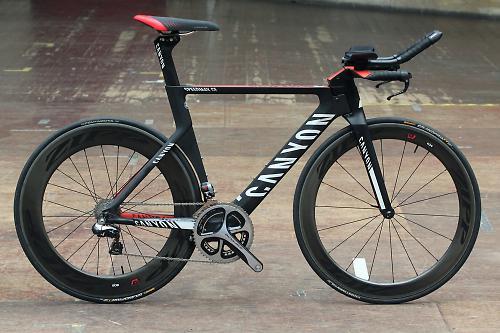
A combination of low weight, a wind tunnel-designed frame and fork and the fast Zipp wheels all help to produce an eye-wateringly fast bike. This thing goes like the clappers, even when you're not putting that much power through the cranks. There's the constant feeling that the Speedmax has deep reserves of speed, always willing and able to go to another level, if you've got the legs for it. Damn, even when you're not even trying to go fast, you find yourself ripping along the road at a terrific pace.
Time trial bikes can have a reputation for tricky handling. And to be uncomfortable. In neither area was the Speedmax anything but flawless. The Speedmax felt brilliantly stable when riding on the handlebar extensions, and even on blustery days it remained composed and didn't buffet off line. And that's despite very deep section wheels – but Zipp's toroidal rim shape really does work well in crosswinds.

The oversized bottom bracket and compact rear triangle give the Speedmax an agile and direct feeling on twistier roads. Plenty of stiffness in the frame ensures that it accelerates up to speed with lightning pace.
The stiffness also ensures the Speedmax takes corners very well too, from slow roundabouts to faster carving turns at high speed. Handling is well balanced with steering that offers a neutral feel, whether on the base bar covering the brake levers or on the extensions.
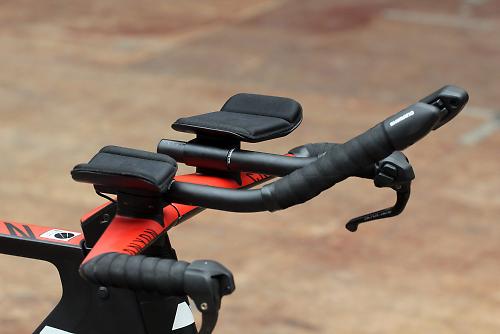
It's a decent weight too and paces up the climbs well, and out-of-saddle sprinting shows the frame tracks cleanly with no twist or squirm.
The other impressive aspect of the Speedmax is just how comfortable it is on rough and broken roads, of which there are plenty on time trial courses around the UK. With a spot of tyre pressure experimentation it's possible to get a fairly smooth ride. The saddle is generously cushioned, which helps for longer efforts and will suit triathletes.

The Speedmax is only sold with Shimano's Di2 groupset, the frame being designed specifically with the wired drivetrain. The Di2 integration is impressive. Having satellite shifters buttons both on the extensions and also on the base bar alongside the brake levers means you can work up through the gears when sprinting up to speed on the base bar, before settling down onto the extensions.

Braking performance from the custom designed and concealed brakes is excellent. I had to fiddle with the brakes to ensure adequate clearance with the wide Zipp rims, but Canyon makes this really easy with access holes in the fork blade to adjust the callipers. More serious brake adjustments mean removing the covering plate from the rear of the fork that hides the brake.

If the bike fits
There are two key requirements for a time trial bike. It needs to be aerodynamic, obviously. It also needs to offer the cyclist enough adjustment that a suitable position can be reached. To achieve the best aerodynamics, Canyon developed the Trident tube profile for the Speedmax using computational fluid dynamics (CFD) and validation in a wind tunnel, along with a bit of input from Simon Smart (the same person who was involved in the Scott Foil, Giant Trinity and Enve rims).
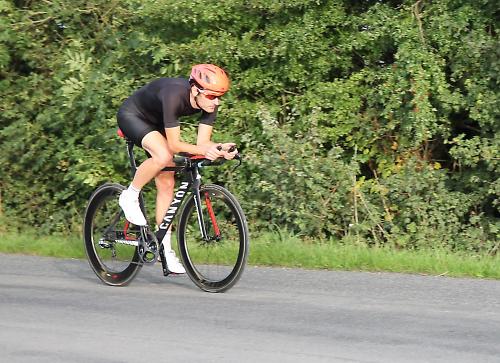
As well as stunning looks, the frame tubes have a curved leading edge with an angular chopped-off tail. Canyon claims the Trident profile provides 10 per cent less drag than a NACA (National Advisory Committee for Aeronautics) drop-shaped profile, and that it's more stable in the wind and stiffer too. All manufacturers make claims for any aerodynamic products, and it's impossible to verify those claims without spending time in a wind tunnel.
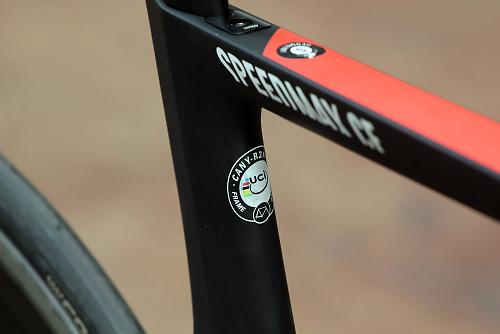
There are many different schools of thought on the best riding position, and it varies as widely in the professional peloton as it does at the local ten. Whatever your preferred position, the cyclist accounts for 80 per cent of the air resistance so Canyon has designed an integrated front end that offers a huge wealth of fit adjustments.
The fit can be further tailored with a choice of different base bar and extension types, so you can really go to town and get it dialled with millimetre precision. Our test bike has a raised stem and flat base bar, but there is a flat stem, in different lengths, and a downswept base bar to choose if you want to get even lower. There are three extensions too, these being the J-bend version. There are different pad widths too, and the extensions can be mounted above or below the base bar.

Canyon also offers two seatposts – one is UCI-legal and the other steepens the seat angle to 78 degrees, appealing to triathletes who aren't stifled by UCI rules. Plenty of choice then. If you're a tinkerer, the Speedmax will keep you busy for a very long time.
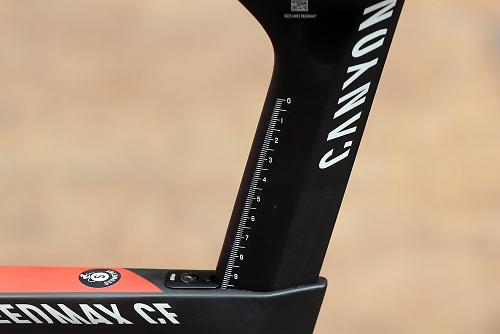
Integration is a big deal in aerodynamics and the Speedmax has most of the cables and wiring concealed inside the handlebar, stem and frame. The front brake cable passes through the steerer tube and headset bearings. That means almost no cabling to provide drag. Canyon has been smart in the way the Di2 junction box is packaged inside the stem, which can be removed by two small side bolts.
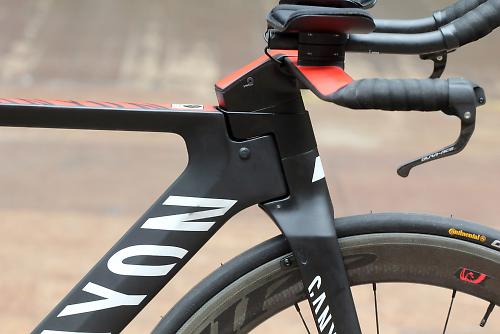
The aero seatpost is wedged into the seat tube with an internal seat clamp, and adjustment is made via a bolt mounted on the top tube. The brakes are integrated too, with Canyon's own centre-pull callipers located behind the fork and under the chainstays, and both covered to reduce drag. Canyon reckons the brakes are 60g lighter than conventional calliper rim brakes, so another benefit there contributing to the low overall weight.

The Speedmax is offered in three sizes, our test bike being a small. I found the fit for my 5ft 11in height perfect. It has a 499mm stack and 410mm reach (the vertical and horizontal measurements from the centre of the bottom bracket to the top of the head tube), 70mm head tube, 539mm seat tube and 583mm top tube. The wheelbase is 989mm and the chainstays are short at 415mm. The head tube angle is 73.25 degrees.
Shimano Di2 all the way
Canyon's direct-sales business model has won it many fans in recent years, with outstanding value for money backed up with really well designed and smartly specified bikes. The range uses the same frame and fork throughout, and each is designed specifically with Shimano's Di2 groupset – there is no mechanical option, nor is there a SRAM or Campagnolo option.
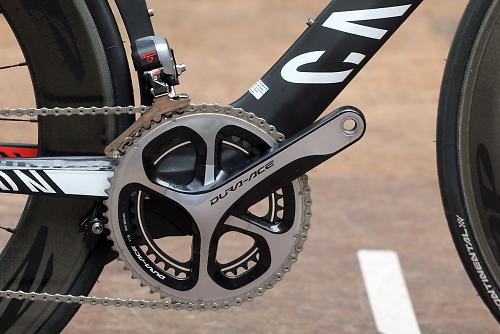
As well as the full Shimano Dura-Ace Di2 groupset and Zipp wheels, it has a Fizik Arione K3 saddle, and 23mm Continental Grand Prix TT tyres. The full build weight is 8.15kg (17.96lb).
Verdict
Impressive speed with sharp handling and smooth comfort – you'll be hard-pushed to find a better TT bike for the money
road.cc test report
Make and model: Canyon Speedmax CF 9.0 SL
Size tested: small, black
About the bike
State the frame and fork material and method of construction. List the components used to build up the bike.
Frame: Canyon Speedmax Cf - F10 Carbon Composite Technology, Specially Developed Carbon Frame And Fork Optimized In The Wind Tunnel, Perfect Aerodynamics With Trident Tubing
Fork: Canyon Aero Fork Sl
Drivetrain: Shimano Dura-ace Di2, 53/39 - 11-25t
Wheels: Zipp 808/404 Firecrest Carbon Clinchers
Tyres: Continental Grand Prix Tt
Saddle: Fizik Arione K3
Tell us what the bike is for, and who it's aimed at. What do the manufacturers say about it? How does that compare to your own feelings about the bike?
Canyon says: The sole objective of the Speedmax CF is to carve through the air and put you at the top of the timing sheets. Maximum speed for minimum watts is what time trial enthusiasts at every level strive for. With our Trident tube profiles, vast adjustability and comprehensive integration of essential components, the Speedmax CF gives you a distinct advantage over the competition even before your start number is called. Nothing is left to chance. No parts are needlessly exposed to the wind. Every single element of this time trial bike is driven towards absolute aerodynamic efficiency.
INTEGRATED COCKPIT
The innovative design of the Speedmax CF cockpit ensures that minimal wires and brakes cables are exposed to the wind with only the connection to the Di2 junction box running outside to achieve an incredibly streamlined profile.
INTEGRATED SEATPOST CLAMP
Designing the seatpost clamp into the top tube further reduces turbulence as air passes across the rear of the frame. A secure hold is guaranteed even at low torque levels so the seatpost never slips out of position as you ride.
INTEGRATED BRAKES
Hidden away from the wind in the forks and chainstays for enhanced aero performance, the centre-pull design delivers outstanding modulation and power while also saving some 60 g over a conventional rim brake configuration.
Frame and fork
Overall rating for frame and fork
9/10
Tell us about the build quality and finish of the frame and fork?
Usual excellent build quality from Canyon and very good attention to detail.
Tell us about the materials used in the frame and fork?
"F10 carbon composite technology with trident tubing optimized in the wind tunnel."
Tell us about the geometry of the frame and fork?
Available in three frame sizes, the size small tested proved a perfect fit, with a huge range of adjustment possible to get the right position.
How was the bike in terms of height and reach? How did it compare to other bikes of the same stated size?
Really good.
Riding the bike
Was the bike comfortable to ride? Tell us how you felt about the ride quality.
Very comfortable with any sort of position easily achieved. Ride comfort was ample to smooth out the rough roads.
Did the bike feel stiff in the right places? Did any part of the bike feel too stiff or too flexible?
No lack of stiffness for sprinting, climbing or pushing as hard as you can on the pedals.
How did the bike transfer power? Did it feel efficient?
Very well, no lack of power transfer when you're on the rivet.
Was there any toe-clip overlap with the front wheel? If so, was it a problem?
No
How would you describe the steering? Was it lively, neutral or unresponsive? Stable
Tell us some more about the handling. How did the bike feel overall? Did it do particular things well or badly?
Really nice handling for a time trial bike, very much like a road bike in fact.
Which components had the most effect (good or bad) on the bike's comfort? would you recommend any changes?
The Zipp wheels are astonishingly fast.
Which components had the most effect (good or bad) on the bike's stiffness? would you recommend any changes?
Didn't make any changes at all.
Which components had the most effect (good or bad) on the bike's efficiency? would you recommend any changes?
The only area where you could experiment might be the tyres, but the Contis didn't cause any issues.
Rate the bike for efficiency of power transfer:
9/10
Rate the bike for acceleration:
8/10
Rate the bike for sprinting:
8/10
Rate the bike for high speed stability:
10/10
Rate the bike for cruising speed stability:
10/10
Rate the bike for low speed stability:
9/10
Rate the bike for flat cornering:
8/10
Rate the bike for cornering on descents:
7/10
Rate the bike for climbing:
7/10
The drivetrain
Rate the drivetrain for performance:
10/10
Rate the drivetrain for durability:
9/10
Rate the drivetrain for weight:
9/10
Rate the drivetrain for value:
7/10
Tell us some more about the drivetrain. Anything you particularly did or didn't like? Any components which didn't work well together?
Shimano Di2 integration is excellent, and the groupset is brilliant for time trials. But you can't buy the Speedmax with any other groupset.
Wheels and tyres
Rate the wheels and tyres for performance:
9/10
Fast wheel and tyre package.
Rate the wheels and tyres for durability:
8/10
Rate the wheels and tyres for weight:
8/10
Rate the wheels and tyres for comfort:
8/10
Rate the wheels and tyres for value:
7/10
Tell us some more about the wheels and tyres.Did they work well in the conditions you encountered? Would you change the wheels or tyres? If so, what for?
The wheel and tyre package is first class and provides plenty of speed, and the rims proved stable in crosswinds.
Controls
Rate the controls for performance:
9/10
Rate the controls for durability:
8/10
Rate the controls for weight:
8/10
Rate the controls for comfort:
9/10
Rate the controls for value:
9/10
Tell us some more about the controls. Any particularly good or bad components? How would the controls work for larger or smaller riders?
The Fizik saddle was comfortable as were the extension bars, with thick foam pads and a good position easy to achieve
Anything else you want to say about the componentry? Comment on any other components (good or bad)
Everything worked flawlessly.
Your summary
Did you enjoy riding the bike? Yes
Would you consider buying the bike? Yes
Would you recommend the bike to a friend? Yes
Rate the bike overall for performance:
9/10
Rate the bike overall for value:
10/10
Use this box to explain your score
Superbly fast, huge range of position adjustment and impressive aerodynamics and integration. The Speedmax is a great choice for anyone looking for a highly capable time trial bike.
About the tester
Age: 31 Height: 180 Weight: 67kg
I usually ride: My best bike is:
I've been riding for: 10-20 years I ride: Every day I would class myself as: Expert
I regularly do the following types of riding: road racing, time trialling, cyclo-cross, commuting, touring, mountain biking
David worked on the road.cc tech team from 2012-2020. Previously he was editor of Bikemagic.com and before that staff writer at RCUK. He's a seasoned cyclist of all disciplines, from road to mountain biking, touring to cyclo-cross, he only wishes he had time to ride them all. He's mildly competitive, though he'll never admit it, and is a frequent road racer but is too lazy to do really well. He currently resides in the Cotswolds, and you can now find him over on his own YouTube channel David Arthur - Just Ride Bikes.
Latest Comments
- imajez 25 min 16 sec ago
- looks like someone has fallen for the steel is real markerting BS. I only care how a bike rides, not what it is made of. I had a lovely steel...
- lonpfrb 1 hour 45 min ago
That argument is ignorance of the widespread height and width restrictions to be found on the many minor roads that were originally created for...
- David9694 4 hours 1 min ago
cyclists should be made to have number plates - Interesting police video here of the range of illegal number plates - we'd got, as the caption says...
- rookybiker 5 hours 14 min ago
The trailer seems to connect to both ends of the rear axle. Can it do tight corners without dragging the tyre sideways?
- froze 5 hours 17 min ago
Motorists have always been unkind to cyclists, but distracted driving is adding to the problem....
- Destroyer666 6 hours 10 min ago
Have you owned Bont shoes? In my experience even the widest Lake shoes have had a bizarre form of narrowing way too much in the toe area. But the...
- froze 6 hours 38 min ago
Not sure if this is possible, but this news letter goes out all over the world, and some places like Decathlon does not send stuff to America, in...
- Hirsute 7 hours 23 min ago
I'm confused as to why you'd need bib shorts indoors.
- Oldfatgit 7 hours 51 min ago
I'm sure you were being sarcastic... however ... Lewis Hamilton lives in Monaco. Yet another car driver that doesn't pay any tax












































Add new comment
3 comments
CANYON carbon bike has advanced profile designed,always...
5 ft 11in on a small , is that a typo, I know you want to get flat and aero but that seems odd.
Canyon are just on fire. Super products and great value.